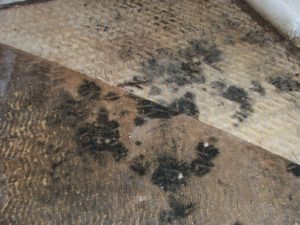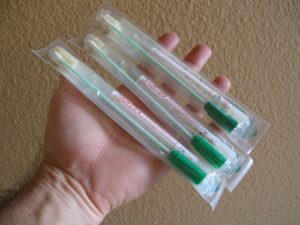
Mold has become a huge issue in the real estate game. It was around before we were all born and even mentioned in the Holy Bible! Mold is a loyal subject of the Kingdom Fungi. But what the heck is it good for? Well, unlike mosquitoes and fleas, it decays dead plant material. Mold can also produce mycotoxins, some are pathogenic, some toxigenic and some allergenic.
It’s not all bad though. Enter the scientist, they’re kinda the mold rodeo cowboys and have found medical, food and commercial uses for the good of society! Mold (fungi) can only grow when moisture, temperature and media conditions (food) are favorable. According to Dr. John Shane PhD with Inspector Lab, most molds thrive between 64 and 90F. Even relative humidity levels between 60 and 75% can support mold growth. Well…mold produces spores which are always lookin’ for a place to live but probably not the type of tenants you really want. The spores float around and infiltrate just about every crook and cranny there is. Enter the human. The toxins released by these molds can enter your mouth, ears, eyes, nose and even your pores.
Exposure to molds like Stachybotrys, Aspergillus and Penicillium can lead to serious health problems which is an entirely different (and much longer subject). There are no standards that state safe or un-safe levels or won’t cause side effects levels. Further and extensive testing may not be conclusive because there is no way to determine how much or what type of exposure a person may have had in the past.
There has always been moisture intrusion/generation, but older houses were not very tight. When things got wet, they also dried out relatively fast. Today…every window, door, outlet, wall/ceiling penetration, floor etc. is sealed so when things get wet via leaks, condensation, inadequate ventilation or whatever they can’t dry out very quickly. Stick a wet shirt inside a cooler, shut it, put it outside and come back in a week. You just lost a shirt. Place a wet shirt outside with plenty ventilation and what happens? It dries out. No moisture, no mold.

The most common testing methods include the spore trap (air sample) and the swab (big Q-Tip). The air sample is calibrated for a specific length of time and at a specific rate. This gives you how much expressed in spores per cubic meter. One exterior control sample is compared to one or more interior samples. The goal in air sampling is to identify an interior mold amplification compared to the exterior. Now…just like anything else, different conditions often produce different results. A sample taken when it’s cold and rainy will likely produce a much different result when it’s hot and humid. And even less obvious, variations within a room can be obtained.
I believe a greater quantity of samples will give you a better idea of conditions than a single sample. The swab will only tell you what (type of mold) but not how much. Different options for different needs. These sample methods both have their pros and cons but keep in mind they provide you with an idea of current conditions so you can make informed decisions.

Will mold be a problem for me? Depends. Sometimes a small amount of mold can trigger an asthma attack in one person and yet no outward symptoms appear in another person. This is why you will not find any government pamphlet that says if YOU are exposed to THIS for THAT amount of TIME, you’ll catch WHATEVER. Each person is different thank God! In an ASHI Reporter article, Home Inspectors and Mold Sampling- Hype or Help?, Mark Cramer states sampling may be useful to prove that something is actually mold when someone disputes the fact or identify allergic (or carcinogenic) molds . I have also done sampling for post remediation condition confirmation.
Common areas that mold is found in (besides the leaky roof/plumbing/wall/window) is around plumbing walls, in AC return plenums and in attics. Some other areas you may not have thought about is in metal duct work when insulation is missing, under your refrigerator in the condensate pan, carpeted areas to/from the pool or under ventilated laundry rooms, kitchens and bathrooms (inoperable vent fans). Even areas like underneath plastic storage boxes or rubber coated carpets and throw rugs. Mold can occur anywhere there is water intrusion or high humidity (hello Florida) and will damage what it grows on.
Mold can range in colors from white, orange, yellow, green, gray, brown, red, blue and black depending on their food source and environmental conditions. You should be cognizant of “moldy” odors. All molds should be respected as if they were toxic. As a mold colony grows, it emanates distinctive odors which are it’s byproducts of metabolism.
Your very first step after recognition is to stop the source of the moisture. The Florida Building Code allows temporary and emergency repairs without pulling permits* (*restrictions apply). You can then proceed with initial/preliminary clean up such as removal of wet carpet, etc. It is important to dry water-damaged areas and items within 48 hours to prevent mold growth. Mold spores also spread when a moldy item such as drywall has had a chance to dry out and spores become airborne, hence items with visible mold should be removed quickly. The initial use of fans may not be advised as you can actually help spread the mold spores. Dehumidification can help the problem from becoming more severe.
I recently performed an air sample in a small 1/1 condo for a person who was particularly sensitive to certain molds. The Aspergillus/Penicillium count was very high. The builder offered to “repair” the affected area…well the follow up air sample revealed triple the previous very high result. Scott Tracy, Certified Mold Remediator, with ServPro says that when remediating an area for mold, it must first be contained, then the remediation can be performed. This builder apparently didn’t hire Scott to develop protocol. Actions taken similar to this builder can cause mold spores to disengage, spread and cross contaminate all kinds of stuff, hence the containment is critical. Scott tells me that pre-testing is preferred prior to remediation but notes that conditions change constantly.
A proper evaluation of the mold and the remediation protocol should be performed by licensed professionals. Not all molds require expensive remediation. Some may simply be treated with a biocide and/or hepa-vac. Tip – Never mix a chlorine bleach solution with other cleaning solutions or detergents that contain ammonia as toxic fumes may be produced. Scott says that hiring a certified remediator will likely run in the $750-$1000 range. An industrial hygienist can easily run $1000 for a report, diagram and protocol. Taking single representative samples by someone like a home inspector is usually in the low hundreds….And… like your home inspection, a sample is a snapshot of immediate conditions in a specific area and may not interpret past or predict future conditions nor would a single sample represent the entire house/building.
There is a great website from the EPA about mold which has a PDF downloadable brochure that can be found at www.epa.gov/iaq/molds/moldguide.html.
Check out our YouTube channel (https://www.youtube.com/user/inspectagator)! Get Orange, Blue & Green Clean and Move In Safe today! https://inspectagator.com/move-in-safe-sanitization/ Our facebook page is full of information and short videos, https://www.facebook.com/theinspectagator/ If you’re looking for a great home inspection company, I just happen to know one, please check out our home inspection company, the Inspectagator, at http://www.inspectagator.com
